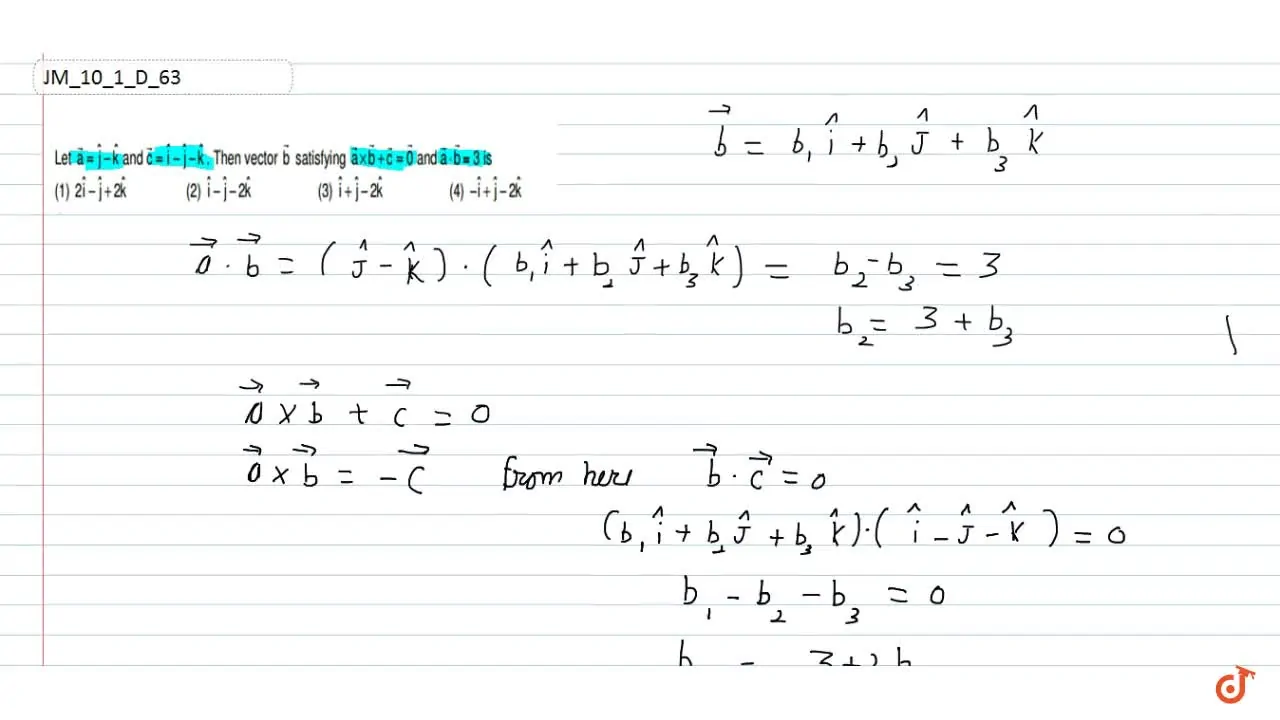Let →a=ˆj−ˆk and →c=ˆi−ˆj−ˆk . Then vector →b satisfying →a×→b+→c=→0 and →a.→b=3 is (1) 2→i−→j+2→k (2) ˆi−ˆj−2ˆk (3) ˆi+j−2ˆk (4) −ˆi+ˆj−2ˆk
Step by step video & image solution for Let vec a= hat j- hat k and vec c= hat i- hat j- hat k . Then vector vec b satisfying vec axx vec b+ vec c= vec0 and vec adot vec b=3 is (1) 2 vec i- vec j+2 vec k (2) hat i- hat j-2 hat k (3) hat i+j-2 hat k (4) - hat i+ hat j-2 hat k by Maths experts to help you in doubts & scoring excellent marks in Class 12 exams.
Related Playlists
Similar Questions
Let →a=ˆj−ˆk and →c=ˆi−ˆj−ˆk. Then the vector b satisfying →a×→b+→c=0 and →a.→b=3, is
View SolutionIf →a=ˆi+ˆj+ˆk,→c=ˆj−ˆk , →a.→b=3 and →ax→b=→c , then →b is equal to
View SolutionIf →a=ˆi+ˆj+ˆk and →b=ˆj−ˆk, find a vector →c such that →a x →c=→b and →a. →c=3
View SolutionLet →a=ˆi+ˆj;→b=2ˆi−ˆk. Then vector →r satisfying →r×→a=→b×→aand→r×→b=→a×→b is ˆi−ˆj+ˆk b. 3ˆi−ˆj+ˆk c. 3ˆi+ˆj−ˆk d. ˆi−ˆj−ˆk
View SolutionIf →a=ˆj−ˆkand→c=ˆi+ˆj+ˆk are given vectors, and →b is such that a →a⋅→b=3and→a×→b+→c=0 then is equal to
View SolutionIf →a=ˆi−ˆj and →b=−ˆj+ˆk find the projection of →aon →b.
View SolutionIf →a=ˆi+2ˆj−2ˆk,→b=2ˆi−ˆj+ˆkand→c=ˆi+3ˆj−ˆk then find →a×(→b×→c)
View SolutionIf →a=5ˆi−ˆj−3ˆkand →b=ˆi+3ˆj−5ˆkthen show that the vectors →a+→band →a−→bare perpendicular.
View SolutionIf →a=3ˆi−ˆj−4ˆk, →b=−2ˆi+4ˆj−3ˆk and →c=ˆi+2ˆj−ˆk,find ∣∣3→a−2→b+4→c∣∣.
View SolutionIf →a=ˆi−ˆj and →b=−ˆj+2ˆk, find (→a−2→b).→a+→b.
View Solution


